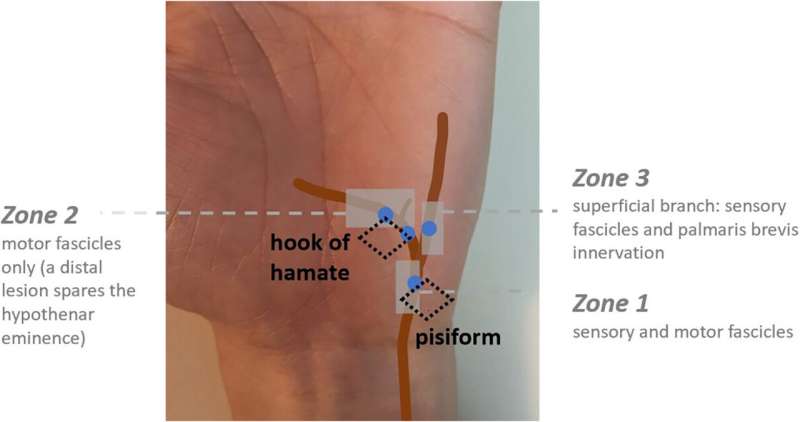This article has been reviewed according to Science X's editorial process and policies. Editors have highlighted the following attributes while ensuring the content's credibility:
fact-checked
trusted source
proofread
Work-related nerve injuries are common with repetitive motions

Although you may not always realize it, many of the jobs you do can put strain on, and even cause damage to, your nerves.
Sandra Hearn, M.D., the associate chair of Education and Professional Development in the Department of Physical Medicine and Rehabilitation, and a team of collaborators, set out to better understand the causes of occupational nerve injuries.
The work is published in the journal Muscle & Nerve.
What is an occupational nerve injury?
An occupational nerve injury refers to a problem with your peripheral nerves that's caused by a work-related activity. It's often seen in manual labor jobs.
Hearn and her team conducted a review that focused specifically on the injuries that occur over time through repetitive motion.
"While some injuries involve unpredictable accidents, like having a limb crushed in machinery or having a vehicle accident at work, we looked at more predictable mechanisms that can injure nerves where they are vulnerable," Hearn said. "These mechanisms often involve repetitive trauma with damage to the nerves over time."
According to Hearn, nerve injuries presenting within the context of specific tasks at work give researchers information about how a common mechanism, across different individuals, can manifest in pathology.
"When we look beyond overt crush injuries or lacerations, we find that several biomechanical stressors underlie many occupational nerve injuries, regardless of which body part is affected," she said.
"These can include compression, stretch, vibration, and repetitive or high-force movements of regional muscles and joints."
The paper's findings
The review found that workers whose jobs required manual labor were most likely to be at risk for an occupational nerve injury. More specifically, jobs that required repetitive movements with high force, such as lifting heavy loads, heavy hammering and repeated squatting, were at the highest of risk.
Although some of these injuries can have an abrupt onset, meaning you can pinpoint when you got hurt and when your symptoms started. But others can occur gradually over time and with continued repetition.
"Many of these injuries present as a cumulative trauma situation, without a clear moment of injury," said Hearn. "For example, it could be that someone has used a jackhammer for many years and starts to develop a syndrome of waking up in the morning with the hands numb."
Hearn says one of the most surprising findings was how specific anatomic variants can predispose your nerves to a greater risk of injury.
"Where a common mechanism exists, anatomic variation can often explain why some workers experience a nerve problem and others do not," Hearn said. "The chances of an individual becoming injured depends on how their nerves respond to the repetitive task."
Each work-related injury is unique. That's why Hearn and her team aimed to learn about the best way to approach the majority of these common work-related injuries so that they could create a reference guide that would work to treat as many patients as possible.
"We recognize that today, occupations and the specific tasks they require, are very diverse. Creating a list of all possible job tasks and associated nerve injuries is essentially impossible," said Hearn.
Their goal, now instead, is to equip clinicians to recognize, when treating workers with possible nerve-related problems, where and how biomechanical factors may interact with the anatomy to damage nerves.
"This understanding can be applied even when patients describe occupations and tasks that vary from those presented in the review. It offers the community plausible diagnoses and appropriate treatments for patients with these work-related nerve injuries."
Additional authors include Shawn P. Jorgensen M.D., Joelle M. Gabet M.D., and Gregory T. Carter, M.D.
More information: Sandra L. Hearn et al, Occupational nerve injuries, Muscle & Nerve (2024). DOI: 10.1002/mus.28099


















